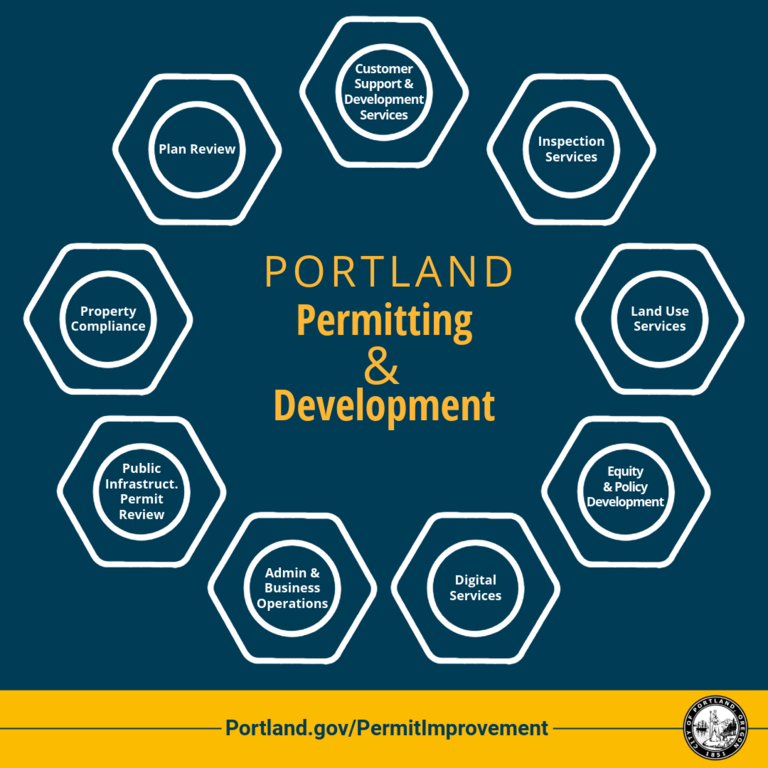
This is going to be another wonky post about development and transportation. If you aren’t interested in development, or if you live in a Portland neighborhood that benefits from a lot of capital projects — public money — you probably don’t have to slog through all this, it’s not of immediate concern to you.
Everybody else, Portland is poised to get a new bureau!
With the proposed creation of Portland Permitting & Development, the city has reached an important milestone in the intense reorganization underway to prepare for our new form of government. This new bureau also marks a significant shift for the Portland Bureau of Transportation. Once the change is adopted by City Council late next month, PBOT will no longer oversee the transportation piece of the development review process.
It’s all a part of what City of Portland Chief Administrative Officer Michael Jordan says is how the city is, “Committed to common-sense improvements that make our government effective and efficient.”
the transportation piece of the development review process is being moved out of PBOT and into PP&D [Permitting and Development]. And that’s a big deal.
The new structure
The new bureau will have about 350 employees, many of them from the Bureau of Development Services, which will become a legacy bureau set for phase-out. One new structural change, however, is that PP&D will also house work groups from the Parks & Recreation, Transportation, Water and Environmental Services bureaus in its Public Infrastructure section.
This reorganization seem to be in response to a damning 2021 audit of the building permit process which concluded that “An essential function of Portland’s building permits system does not work as it should.”
One noteworthy thing about the 2021 audit was that it singled out Portland’s antiquated Commissioner form of government as part of the problem:
Portland’s fragmented form of government exacerbates the situation. Seven bureaus and City Council are responsible for plan reviews, but no one entity manages systemwide performance. The bureaus have important improvement projects underway that were progressing slowly even before the pandemic. Meanwhile, the more difficult work to address persistent concerns about Portland’s complex regulatory environment has stalled altogether.
That same year, Commissioners Dan Ryan and Mingus Mapps began the work of streamlining permitting by appointing a large Permit Improvement Task Force comprised of civil servants from the permitting bureaus (Transportation, BES, Parks, Fire, Forestry, Water). The new PP&D bureau appears to be the result of all that behind-the-scenes effort.
Regulatory reform
Unlike with the internal structural reform, BikePortland has been closely covering this year’s public-facing push toward housing regulatory reform, beginning with Commissioner Carmen Rubio’s survey of development stakeholders, continuing with the proposed code changes to bike parking requirements, and landing with the Planning Commission’s vote to recommend the Housing Regulatory Relief Project to the Portland City Council.
(Yep, all that happened in just one year.)
What it means for a BikePortland reader
The structure of the new bureau appears to address many of the issues about inefficiency raised in both the 2021 audit and the 2023 development stakeholder survey. But what does this insider baseball mean for a BikePortland reader?
Well, let’s start with me. For three and a half years, I’ve been trying to explain to BikePortland readers that not every bit of road work is a capital project. Yes, the Portland Bureau of Transportation (PBOT) has a Planning section with lots of project managers, and they do community outreach, surveys, meetings, and eventually big ticket changes like on Division Street, or 82nd Avenue get built.
But PBOT also has a development review section which oversees changes to the right-of-way triggered by new construction, and for which developers foot the bill. My stories about the new apartment building on Gibbs St (which went in without a curbed sidewalk), or the proposal for the Alpenrose site — and whether a sidewalk and bike lane on Shattuck will be part of it it — have all been about decisions made in the development review process. Got it?
What is happening with the current restructuring is that the transportation piece of the development review process is being moved out of PBOT and into PP&D. And that’s a big deal. It affects things like having a place to park your bike, a lane to ride in, and whether your neighborhood has sidewalks or not. Like it or not, development review is where a lot of decisions about the right-of-way are made.
It’s a good change, not the least because there is a chasm between the cultures of Planning and that of Development Review. An event organized by a Planning team will have a friendly slide show, maybe some refreshments, “and here’s some crayons for the kids.” Conversation tends to be aspirational.
At a development review meeting, people sometimes show up with lawyers. Conversation is about legal requirements, and the cost of frontage improvements. And what the public sector can fairly exact from private owners. So moving the activities of transportation development review away from PBOT and into the new bureau distinguishes between the two funding sources (public and private) and relieves PBOT of overseeing development review activities which I often felt the rest of the organization did not know much about.
After May 22nd, when the City Council votes on the proposed reorganization, I will no longer have to write “the development review section of the Portland Bureau of Transportation.” PP&D will do just fine.




